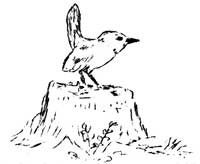WESTERN WINTER WREN
(Olbirochilus hiemalis pacificus)

Although it is true that very few birds dwell in the dense
lower-slope forests, (where the tangle of fallen logs are covered with a
deep upholstering of damp mosses, and the sunlight only filters through
the canopy of interlacing boughs of midday) a traveller, in summer or
winter, is seldom beyond hearing of bird notes.
Most of these songs of the deep woods come from the throat of one
bird: the tiny Western Winter Wren. About the size of a house wren,
dark brown above and a shade lighter beneath, he is conspicuous for his
cheery song and energetic behavior only. He seems as much a part of the
shadowy forest floor as the mosses, huckleberry vines, huge logs, and
upturned roots of his surroundings. Ordinarily the Winter Wren does not
venture more than six feet above the ground but is want to suddenly
issue from beneath a huge, mossy log, quite close to the observer, and
give his usual command to "chek-chek, check-check." If approached he
dodges back under the log or slips silently away into some handy root
tangle. Food, nesting site, and approved living conditions are all
furnished in abundance by his forest floor habit.
(From Walter P. Taylor, U.S.B.S.)
SONGS OF SPRING
The Spring Break-up is apparently at hand or is it a false alarm?
The weather for a month has been remarkable for its variety. That old
woodsman's song which goes something like this, describes it to a
"T":
"First it rained and then it blew;
Then it friz and then it snew;
Then it fogged and then it thew;
And very shortly after then
It blew and snew and thew again."
But these are not the only signs of spring. Last Sunday the first
robin returned and yesterday we saw a Varied Thrush near the Entrance.
For a week chipmunks have appeared (each time the sun breaks through the
clouds) and have scampered over exposed logs and chattered with ecstatic
joy. Down in the valley the pussy-willows are silver-gray and the
yellow leaves of the skunk cabbage are breaking through the tangle of
decayed vegetation in the swamps. Surely spring cannot be far
distant.


